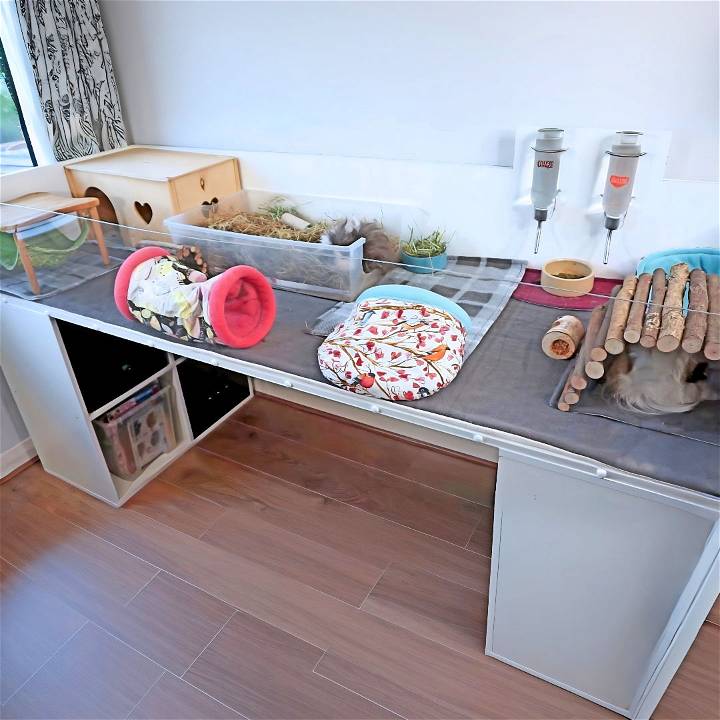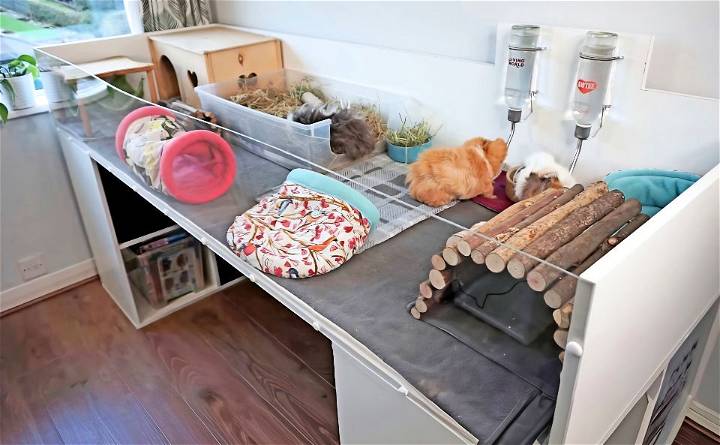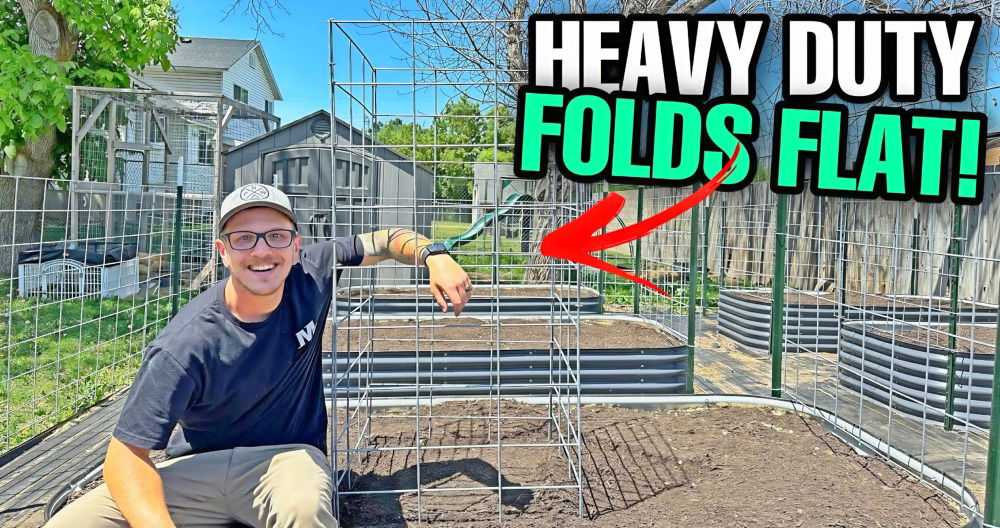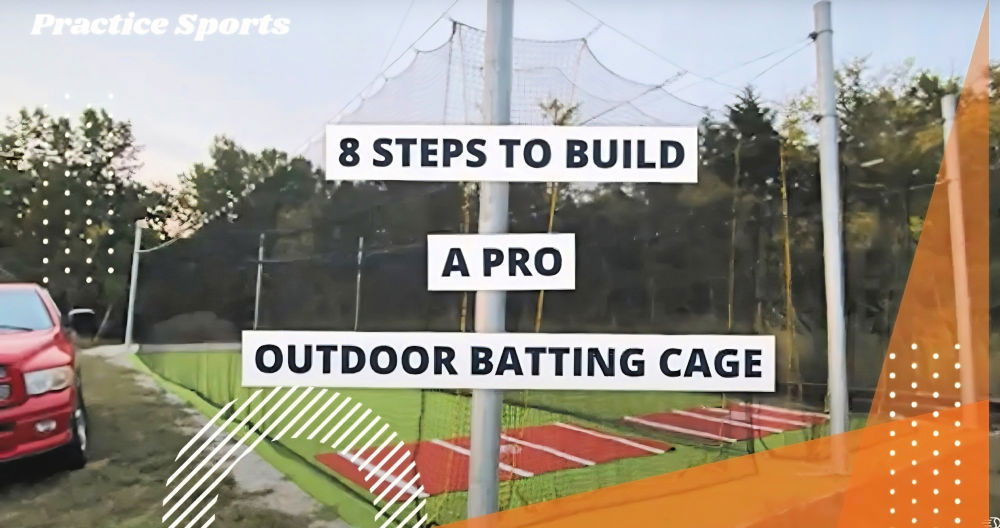Building a DIY guinea pig cage ensures a healthy habitat for your furry friend. It’s not just cost-effective but also lets you make a comfortable environment for your pet. Proper planning and materials are key to making a safe and engaging home for your guinea pig.
Knowing how to make a guinea pig cage is important for maintaining your pet's well-being. You can include features like multiple levels, hiding spots, and chew toys to keep them entertained. By using safe, non-toxic materials, you ensure the cage is secure. Ready to get started? Follow our guide and build the perfect home for your guinea pig!

Now, let's move on to the specific steps and materials needed to bring your DIY guinea pig cage project to life.
Why Build Your Own Cage?
Before diving into the how-tos, it's important to understand the benefits. Firstly, customizing your cage allows for a perfect fit within your living space. It also means you can tailor the size and features according to your guinea pigs' needs, ensuring their happiness and well-being. Plus, the modern, sleek design I was aiming for would be a delightful addition to my home d* écor.
Materials Needed and Their Purpose
- Conti Board: The main material for the cage's structure, chosen for its durability, ease of cleaning, and the modern look it offers.
- Ikea Storage Units: These units serve as the base of the cage, providing a sturdy foundation and valuable storage space for guinea pig supplies.
- Plexiglas: Used for the front panel to keep the cage secure while allowing clear visibility and interaction with the guinea pigs.
- White Iron-On Tape: Necessary for covering the raw edges of the Conti board, giving the cage a finished and polished look.
- Aquarium Sealant: Essential for sealing edges and corners to ensure the cage is safe and escape-proof for the guinea pigs.
Step by Step Instructions
Learn how to build a DIY guinea pig cage with our step-by-step guide. Includes planning, assembling, attaching the plexiglas front, and finishing touches.
Planning and Measurements
The journey began with sketching out the design and taking precise measurements. I decided on a cage size of 70 cm by 2 meters, which offered ample space for up to four guinea pigs. Ensuring the dimensions matched the Ikea units beneath was crucial for a seamless fit.
Assembling the Base and Structure
With Conti board and Ikea units on hand, I set to work. The process was straightforward:
- Cutting Conti Board: I ordered my Conti board cut to the exact measurements from a local timber merchant, saving time and ensuring precision.
- Assembly: Starting with attaching the back piece to the base, I drilled pilot holes every 20 cm or so, using wood screws for a secure fit. Side panels followed, with careful attention to keeping everything aligned and sturdy.
Attaching the Plexiglas Front
The Plexiglas front required a delicate touch. Drilling holes for screws demanded patience and a steady hand to avoid cracks. Although I did encounter a minor crack, it ultimately added character to the cage, serving as a reminder of the learning process involved in DIY projects.
Finishing Touches
Ironing on the white tape to cover raw edges was a satisfying final step in the construction. Sealing the base and corners with aquarium sealant ensured no moisture could escape, and the cage remained easy to clean.
Lessons Learned
- Patience Is Key: Rushing can lead to mistakes, especially when drilling Plexiglas. Taking my time would have prevented the small crack I ended up with.
- Sharp Tools Are Essential: Whether cutting iron-on tape or modifying materials, sharp tools make the job cleaner and easier.
Customization Ideas for Your DIY Guinea Pig Cage
Making a home for your guinea pigs is more than just building a cage; it’s about crafting a space that’s comfortable, stimulating, and uniquely theirs. Here are some customization ideas to help you design a habitat that will keep your furry friends happy and healthy.
Add Levels and Ramps
Guinea pigs love to explore. Adding multiple levels connected by ramps can provide them with exercise and entertainment. Ensure ramps have a gentle incline and are wide enough for safe passage. You can use untreated wood or sturdy cardboard for these structures.
Make Hideaways
Guinea pigs need privacy and places to hide. Incorporate little hideouts using PVC pipes, small wooden boxes, or even overturned plant pots with an entrance cut out. These cozy retreats are perfect for when your pets need some quiet time.
Offer a Variety of Textures
Different floor textures can stimulate your guinea pigs’ sense of touch. Consider sections with grass mats, fleece bedding, or smooth tiles for cooling down. Each area offers a unique feel and can help keep their feet healthy.
Include Chewable Accessories
Guinea pigs need to chew to keep their teeth in check. Add chew toys made from safe, untreated wood, hay cubes, or woven grass products. These not only provide dental health benefits but also serve as entertainment.
Install a Feeding Station
Designate an area for feeding that’s easy to clean. A slightly raised platform with a rim can contain spills and help maintain hygiene. Use ceramic dishes for stability and to prevent tipping.
Set Up a Play Zone
Dedicate a section of the cage for playtime. Include tunnels, balls, and movable toys to encourage physical activity. You can even DIY some toys using safe, household items.
Personalize with Safe Paints
If you want to add a splash of color, use pet-safe, water-based paints to decorate the exterior. Avoid painting inside the cage or any surfaces your guinea pigs might chew on.
Think Vertical for Plants
Guinea pigs enjoy fresh greens, so why not grow some right in their home? Set up a small, secure planter with guinea pig-safe plants like parsley or cilantro. Ensure plants are out of reach so they can’t be overeaten.
By incorporating these ideas, you’ll make a stimulating environment that caters to your guinea pigs’ natural behaviors and needs. The key is to use safe, non-toxic materials and to ensure everything is secure and guinea pig-proof.

Maintenance and Cleaning Guide
Keeping your DIY guinea pig cage clean is crucial for the health and happiness of your pets. A clean habitat prevents diseases and ensures your guinea pigs are comfortable. Here’s a straightforward guide to maintaining and cleaning your guinea pig cage.
Daily Spot Cleaning
Every day, take a few minutes to remove soiled bedding, uneaten food, and droppings. Use a small hand-held vacuum or a dustpan and brush to tidy up the area. This will keep the cage fresh and reduce the need for deep cleaning.
Weekly Bedding Change
Once a week, replace all the bedding in the cage. If you use fleece liners, shake them out and wash them in a washing machine. For wood shavings or paper-based bedding, dispose of them responsibly and lay down a fresh layer.
Monthly Deep Clean
Set aside time each month for a thorough cleaning. Remove everything from the cage and wash it with hot, soapy water. Rinse well to remove any soap residue. For disinfecting, use a half-and-half solution of white vinegar and water. Avoid harsh chemicals that can harm your guinea pigs.
Clean Feeding and Water Areas
Food and water areas can get messy quickly—clean bowls and bottles daily with hot, soapy water. Check for algae or mold growth in water bottles and scrub them out regularly.
Check for Wear and Tear
Inspect the cage for any signs of damage, such as chewed areas or loose parts. Repair or replace any unsafe elements to keep the cage secure.
Odor Control
To help control odors, sprinkle a thin layer of baking soda under the bedding. It’s safe for guinea pigs and can absorb smells. Just make sure it’s not accessible for them to ingest.
Record Keeping
Keep a cleaning schedule to track when you’ve performed each task. This will help you maintain a routine and ensure nothing is overlooked.
By following this guide, you’ll make a clean and inviting space for your guinea pigs, and you’ll also make the cleaning process efficient and manageable for yourself.
Safety and Comfort Tips
When it comes to making a DIY guinea pig cage, the safety and comfort of your little companions should be your top priority. Here’s a guide to ensure your guinea pig’s home is a safe haven.
Choose Safe Materials
Always select materials that are non-toxic and safe for guinea pigs. Avoid treated woods, sharp edges, or small parts that could be swallowed. Wire flooring should be avoided as it can hurt their delicate feet.
Secure the Structure
Make sure the cage is sturdy and secure. Check that all doors and lids close properly to prevent escapes. If you’re using mesh, ensure the gaps are small enough so your guinea pigs can’t squeeze through.
Provide Adequate Space
Guinea pigs need room to move, play, and exercise. The recommended cage size is at least 7.5 square feet for one guinea pig, with an additional 2-3 square feet for each additional guinea pig.
Ensure Proper Ventilation
Good airflow is essential to keep the cage environment fresh. However, avoid placing the cage in direct drafts or under air conditioning vents, as guinea pigs are sensitive to temperature changes.
Maintain a Comfortable Temperature
Guinea pigs thrive in temperatures between 65°F and 75°F (18°C to 24°C). Keep the cage away from direct sunlight, heaters, and other sources of extreme heat or cold.
Soft Bedding for Sensitive Feet
Use soft bedding like fleece or paper-based products. These materials are gentle on guinea pig paws and can be easily cleaned. Avoid cedar or pine shavings, as the oils can be harmful.
Make a Quiet Zone
Guinea pigs are prey animals and can be easily startled. Place the cage in a quiet area of your home where there is less foot traffic and noise.
Regular Health Checks
Incorporate a routine to check your guinea pigs for any signs of injury or illness. Early detection is key to preventing and treating health issues.
By following these tips, you’ll make a safe and cozy environment that will keep your guinea pigs healthy and content. A happy guinea pig is a playful and affectionate pet!
FAQs About DIY Guinea Pig Cage
Discover essential faqs about DIY guinea pig cages. Learn how to build a safe, spacious, and fun habitat for your guinea pigs!
The cage should provide ample space for your guinea pig to move around comfortably. For one guinea pig, aim for a minimum of 7.5 square feet of floor space. For two guinea pigs, 10.5 square feet or more is recommended. The bigger the cage, the better for your pet’s well-being.
Yes, you can build a multi-level cage. Ensure that ramps between levels are gentle and safe for your guinea pigs to climb. Adding levels can provide more space for exercise and exploration.
While an outdoor cage can provide fresh air and grass, it’s only safe in warm weather and should be secure from predators. During colder months, or if you live in a predator-rich area, it’s best to keep the cage indoors.
Cleaning is straightforward:
Remove your guinea pigs and place them in a safe area.
Take out all toys, bedding, and accessories.
Wipe down the grids and walls with a pet-safe disinfectant.
Replace or wash the coroplast or plywood base.
Reassemble the cage and return everything to its place.
The bedding in your guinea pig cage should be replaced at least once a week. However, if you notice it becoming damp or soiled more frequently, it’s important to change it more often to maintain a clean and healthy environment for your pets. For best results, spot clean daily to remove waste and uneaten food.
Final Thoughts
In conclusion, making a DIY guinea pig cage for a healthy habitat can be a rewarding project that ensures your pet's well-being. With the right materials and some patience, you can build a comfortable and safe DIY guinea pig cage. Our step-by-step guide on how to make a guinea pig cage provides all the necessary information to get started.













